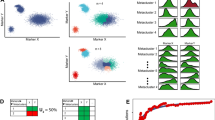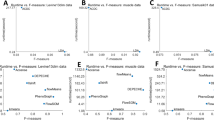Abstract
Mass cytometry is one of the most popular single-cell technology that can measure over 50 markers simultaneously for millions of cells. Due to the high-dimensional nature of the dataset, manual analysis is difficult. Furthermore, during biological sample preparation, some problems may arise that need to be dealt with. One of the problems is a batch effect that can be introduced to the data because of experimental design or different experimental settings and techniques used. There are several bioinformatical solutions to correct the batch effect. Some of them require technical replicates (CytofBatchAdjust, CytoNorm and CytofRUV), others can work for a limited number of cells only (iMUBAC). An interesting aspect is how the batch correction method affects the results in terms of the number and quality of identified cell groups and to what extent the batch effect was removed. In the study, the two batch effect methods were compared, that do not require technical replicates, cyCombine and iMUBAC, applied to a real dataset with over 2 million bronchoalveolar lavage cells. Results were presented with the original mISO plots. Cells were clustered based on the original and corrected marker profiles with the PARC algorithm. After the correction, the number of clusters decreased from 24 to 22 (iMUBAC) and 18 (cyCombine). The homogeneity of clusters expressed as an effect size measure increased after the cyCombine correction (p-value = 4.38*10–7) in contrast to iMUBAC (p-value = 0.4628). The results indicate the superiority of cyCombine over iMUBAC for the real dataset if the within-cluster marker profile similarity is considered.
Access this chapter
Tax calculation will be finalised at checkout
Purchases are for personal use only
Similar content being viewed by others
References
Bjornson, Z.B., Nolan, G.P., Fantl, W.J.: Single-cell mass cytometry for analysis of immune system functional states. Curr. Opin. Immunol. 25(4), 484–494 (2013)
Atkuri, K.R., Stevens, J.C., Neubert, H.: Mass cytometry: A highly multiplexed single-cell technology for advancing drug development. Drug Metab. Dispos. 43(2), 227–233 (2015)
Pedersen, C.B., et al.: Robust integration of single-cell cytometry datasets. bioRxiv (2021)
Schuyler, R.P., et al.: Minimizing batch effects in mass cytometry data. Front. Immunol. 2367 (2019). https://doi.org/10.3389/fimmu.2019.02367
Van Gassen, S., Gaudilliere, B., Angst, M.S., Saeys, Y., Aghaeepour, N.: CytoNorm: A normalization algorithm for cytometry data. Cytometry A 97(3), 268–278 (2020)
Van Gassen, S., et al.: FlowSOM: Using self-organizing maps for visualization and interpretation of cytometry data. Cytometry A 87(7), 636–645 (2015)
Trussart, M., Teh, C.E., Tan, T., Leong, L., Gray, D.H., Speed, T.P.: CytofRUV: Removing unwanted variation to integrate multiple CyTOF datasets. bioRxiv (2020)
Ogishi, M., et al.: Multibatch cytometry data integration for optimal immunophenotyping. J. Immunol. 206(1), 206–213 (2021)
Korsunsky, I., et al.: Fast, sensitive and accurate integration of single-cell data with harmony. Nat. Methods 16(12), 1289–1296 (2019)
Johnson, W.E., Li, C., Rabinovic, A.: Adjusting batch effects in microarray expression data using empirical Bayes methods. Biostatistics 8, 118–127 (2007)
Stassen, S.V., Siu, D.M., Lee, K.C., Ho, J.W., So, H.K., Tsia, K.K.: PARC: Ultrafast and accurate clustering of phenotypic data of millions of single cells. Bioinformatics 36(9), 2778–2786 (2020)
McInnes, L., Healy, J.: UMAP: Uniform Manifold Approximation and Projection for Dimension Reduction. ArXiv e-prints 1802.03426 (2018)
Acknowledgment
AS benefits from the European Union scholarship through the European Social Fund (grant POWR.03.05.00–00-Z305). JP was financed by 02/070/BK_22/0033 project. Calculations were carried out using GeCONiI infrastructure funded by NCBiR project no. POIG.02.03.01–24-099/13.
Author information
Authors and Affiliations
Corresponding authors
Editor information
Editors and Affiliations
Rights and permissions
Copyright information
© 2022 Springer Nature Switzerland AG
About this paper
Cite this paper
Suwalska, A., du Plessis-Burger, N., van der Spuy, G., Polanska, J. (2022). Comparison of Batch Effect Removal Methods for High Dimensional Mass Cytometry Data. In: Rojas, I., Valenzuela, O., Rojas, F., Herrera, L.J., Ortuño, F. (eds) Bioinformatics and Biomedical Engineering. IWBBIO 2022. Lecture Notes in Computer Science(), vol 13347. Springer, Cham. https://doi.org/10.1007/978-3-031-07802-6_34
Download citation
DOI: https://doi.org/10.1007/978-3-031-07802-6_34
Published:
Publisher Name: Springer, Cham
Print ISBN: 978-3-031-07801-9
Online ISBN: 978-3-031-07802-6
eBook Packages: Computer ScienceComputer Science (R0)




